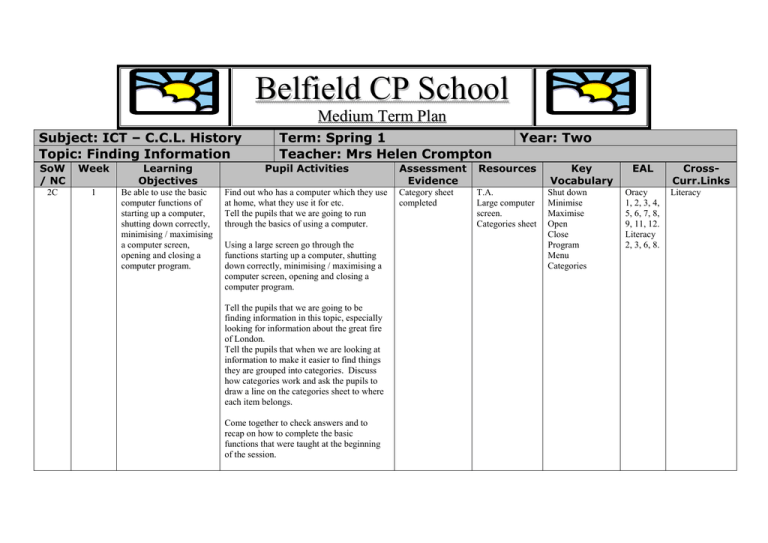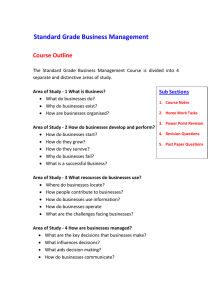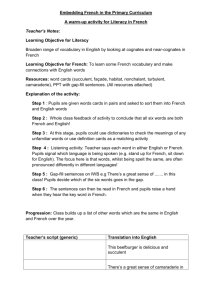B e l f
advertisement

Belfield CP School Medium Term Plan Subject: ICT – C.C.L. History Topic: Finding Information Term: Spring 1 Teacher: Mrs Helen Crompton SoW / NC Week Learning Objectives Pupil Activities 2C 1 Be able to use the basic computer functions of starting up a computer, shutting down correctly, minimising / maximising a computer screen, opening and closing a computer program. Find out who has a computer which they use at home, what they use it for etc. Tell the pupils that we are going to run through the basics of using a computer. Using a large screen go through the functions starting up a computer, shutting down correctly, minimising / maximising a computer screen, opening and closing a computer program. Tell the pupils that we are going to be finding information in this topic, especially looking for information about the great fire of London. Tell the pupils that when we are looking at information to make it easier to find things they are grouped into categories. Discuss how categories work and ask the pupils to draw a line on the categories sheet to where each item belongs. Come together to check answers and to recap on how to complete the basic functions that were taught at the beginning of the session. Year: Two Assessment Evidence Resources Key Vocabulary Category sheet completed T.A. Large computer screen. Categories sheet Shut down Minimise Maximise Open Close Program Menu Categories EAL Oracy 1, 2, 3, 4, 5, 6, 7, 8, 9, 11, 12. Literacy 2, 3, 6, 8. CrossCurr.Links Literacy 2C 2 To know that CD ROMs contain large amounts of information. To use buttons to navigate a CD ROM. Looking at a set of books and a CD ROM ask the pupils which they think will hold the largest amount of information. Is it easier to get at the information? Is it quicker? Will it look the same? How do you find the information in the book and in the CD ROM? Sheets with information found. T.A. Computers T.A. CD ROMS Books Finding information sheets. CD ROM Books Information Access Menu Oracy 1, 2, 3, 4, 5, 6, 7, 8, 9, 11, 12. Literacy 2, 3, 6, 8. Literacy History Oral feedback and observation of pupils. Computers T.A. CD ROMS CD ROM Books Information Hyperlink Menu Index keyword Oracy 1, 2, 3, 4, 5, 6, 7, 8, 9, 11, 12. Literacy 2, 3, 6, 8. Literacy History Show the class how to navigate around the CD ROM. Explain that you are asking the pupils to find as much as they can on one subject by using books and by using the CD ROM give the pupils a sheet with one side for information found on the CD ROM and the other information found in the books. Split the group into two one group using the CD ROMs the other using books and swapping half way. Come back as a group to look at the information found and if they found the information easier to access more on one than the other. 2C 3 How to navigate around a CD ROM and the name and the particular functions. Re-cap on what we know so far about navigating around the CD ROM discuss the words menu, index and keyword. Demonstrate how to use these tools to find the information that we want. Look at the use of hyperlinks. In groups use the CD ROMS to find information requested by the teacher which will be chosen regarding ability. Quick question and answer session. 2C 4 To know that CD ROMs contain large amounts of information. Search a CD Rom using the index and menu. Re-cap how to shut down the computer. Re-cap on last weeks work about using books and a CD ROM to find information. Oral feedback and observation of pupils. Computers T.A. CD ROMS Large screen. CD ROM Books Information Access Index Glossary Menu Oracy 1, 2, 3, 4, 5, 6, 7, 8, 9, 11, 12. Literacy 2, 3, 6, 8. History Literacy Oral Q & A also observations of pupils. Computers with internet access. T.A. Large screen. Books Information Access Menu Search engines hyperlinks Oracy 1, 2, 3, 4, 5, 6, 7, 8, 9, 11, 12. Literacy 2, 3, 6, 8. Literacy History Look at the CD ROMs again as a group and discuss the index and glossary to see how it is useful as we find information. Do all CD ROMs have an index and glossary? Different types of CD ROMs and if they all hold information. One group on the carpet looking at a CD Rom on a large screen teacher demonstrating navigation the others looking for information on CD ROMs in pairs. Swap groups half way. Share the useful information we found, and discuss any problems with other pupils giving suggestions. 2C 5 Know that there are lots of different ways of finding information and how the information was found from the past. The function of search engines to find information on the internet. Recap on how information is available in books and CD ROMs. What other ways could we find information? (Internet, people, visits) Move the focus on to the Internet, recap on how information was found by looking at the menu and the different categories. Do pupils know how information is found on the internet? Using a train and cards do a demonstration of how search engines find the information we want. Demonstrate by now using a search engine on the internet putting in different words. (Not too specific) In twos or threes go on the search engines looking generally. Less able working with me on the carpet doing searches. Working together split up instructions of how to shut down the program and then the computer. 2C 6 To search the internet using a search engine Know the function of hyperlinks. Recap on use of internet to find out information, search engines, hyperlinks etc. Oral Q & A also observations of pupils. Pupils use computers and laptops with internet access to find out information about ‘The Great Fire of London’ using the skills they have found out. Teacher printing off information that they have found. Pupils under supervision shut down computers, less able on laptops more able on suite computers. Look at the information we have found from the internet, discuss the advantages and disadvantages of using the different types of sources of information. This ICT unit is to be taught in conjunction with the Yr 2 History, Unit 5, The Great Fire of London. Computers and laptops with internet access. T.A. Information Access Menu Search engines Hyperlinks Curser Oracy 1, 2, 3, 4, 5, 6, 7, 8, 9, 11, 12. Literacy 2, 3, 6, 8. Literacy History






